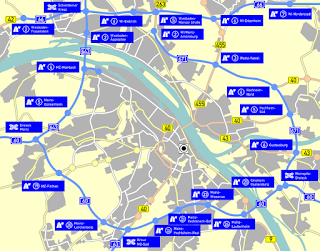 |
| No wonder this lion looks so smug: he’s caught a sheep. |
As I mentioned in the video, Mainz has a lot of historic buildings embedded among the more modern stuff, and there are very few places where you feel you’re standing in the middle of an ancient city. This means that wandering off through the quiet back streets isn’t often as rewarding as it is in most places: in fact, it can be a bit dispiriting.
The city is surrounded by a ring of autobahns, so in theory it’s not that hard to get to. You might want to approach it from the south and west, rather than the north and east, to avoid having to cross the river on the one (non-autobahn) bridge that exists, and which dumps you right into the middle of the city traffic.
Mainz is just west of Frankfurt: S-Bahn line S8 goes from Frankfurt via Frankfurt Airport to Mainz (and then on to Wiesbaden), stopping at Römisches Theater and the central station. Lines S1 and S9 go via Mainz-Kastel (confusingly, now a suburb of Wiesbaden), the station being right next to the reduit, and from there it’s an easy walk across the bridge. Mainz’s central station is, of course, a major stop for long-distance trains.
Local public transport is probably quite good in Mainz, but at the moment there are road construction projects going on that have resulted in several tram lines being truncated or rerouted. Unfortunately, information about diversions and replacement buses is very hard to find and confusing when you do: even the locals seem to be unsure about how to get from A to B.
 |
| Which way to the river? |
Mainz has an interesting quirk which, in theory, is supposed to help with orientation. Street name signs come in two colours: red for streets that run toward the river, blue for streets that run parallel to it. House numbers go up either as you get closer to the river, or with the direction of flow of the river, always with odd numbers on the left.
This would be a very helpful if Mainz was on a grid layout, but of course it’s not. You will still need Google Maps. But at least it was an attempt (in 1853) to make finding your way fractionally less daunting, as Mainz really is very easy to get lost in.
And that, folks, is why I needed two visits and still didn’t get everything.


